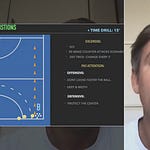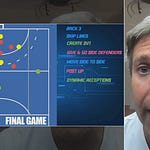Managing transitions was the topic of the masterclass by Andreu Enrich and it resulted in a very interesting presentation and conversation.
Enrich is a Spanish coach who has been coaching in Germany for Mannheimer for 5 years now and was recently added to the coaching staff of the German men’s team.
For The Hockey Site he hosted earlier masterclasses on the Pygmalion effect together with Ric Charlesworth and David Harte. As well as tactical dilemmas or for example tips from intelligent players, both based on his books.
Mastering Transitions in Field Hockey: Insights from Andreu Enrich
Managing transitions is a crucial aspect that often gets overlooked by coaches. Today, we dive deep into the world of transitions, focusing on the moments when teams switch between attacking and defending.
Understanding Transitions
At its core, a transition occurs when one team loses possession of the ball and the other team quickly shifts to capitalize on the opportunity. There are two main types of transitions:
Offensive Transition: This is when your team regains the ball and immediately looks to attack.
Defensive Transition: This occurs when your team is attacking, loses the ball, and must quickly switch to a defensive posture.
Andreu emphasizes that transitions are inherently unpredictable. Unlike set plays such as outlets or long corners, which can be planned and practiced, transitions are dynamic and unique to each situation. This unpredictability makes training and managing these moments even more critical.
The Duration of Transitions
One common question is, "How long does a transition last?" The answer varies. A transition continues until the team regains organization—whether that means getting behind the ball in a defensive stance or successfully moving the ball in an offensive phase. As soon as the players find their positions and the game stabilizes, the transition ends. Until then, it’s all about reacting quickly and efficiently.
Offensive Transitions: A Closer Look
When executing an offensive transition, players should keep in mind two forces at play:
Aggressive Force: This is the drive to attack the opponent's goal as quickly as possible.
Conservative Force: This involves maintaining possession and avoiding risky plays.
In an ideal situation, once the ball is regained, the first question to ask is, "Is there a pass forward?" If the answer is yes, that pass must be played. If not, players should look to run forward with the ball or play laterally to reset the situation. If none of these options are available, protecting the ball and playing backward to maintain possession is key.
Andreu highlights that this decision-making process should be quick and instinctive. The more players practice these heuristics, the better they will become at executing successful transitions in real game scenarios.
Defensive Transitions: Key Strategies
Once the ball is lost, the focus shifts to defensive transitions. The priority is to regain possession as quickly as possible. This can be achieved through counter-pressing:
The player who loses the ball—or the closest player to the loss—must react quickly and apply pressure to the opponent with the ball.
Surrounding players should close down space and prevent easy passes, all while avoiding being eliminated from the play.
Players further back must mark opponents closely to limit their options.
This strategy ensures that even if the initial counter-press fails, the team can still regroup and defend effectively, thus optimizing their chances of regaining the ball.
Integrating Transitions into Training
One of the challenges coaches face is teaching players to think about transitions. It requires more than just classroom discussions; it demands deliberate practice. Coaches should create training scenarios that emphasize chaotic, transition-heavy situations, allowing players to experience and react to these moments in real-time.
FAQs About Managing Transitions
What are some effective drills for practicing transitions?
Drills that involve small-sided games with frequent changes of possession can be very effective. Coaches should emphasize quick decision-making and encourage players to think about their next move immediately after regaining the ball.
How can younger players understand the importance of transitions?
For younger players, the focus should be on the basic principle of running back when possession is lost. Reinforcing this behavior through fun drills and games can help them grasp the concept of transitions without overwhelming them with details.
Do the same principles apply in different zones of the pitch?
Yes, the principles of transitioning remain consistent regardless of where on the pitch the ball is regained. Players should always prioritize playing forward when possible, regardless of their location.
In conclusion, managing transitions effectively is a game-changer for any coach in hockey. By understanding and practicing both offensive and defensive transitions, coaches can enhance their team's performance and adaptability on the field.
Enjoy the full video above with lots of examples from recent Pro League games and much more from Andreu Enrich :)
Some shorter clips ↓
Listen to this episode with a 7-day free trial
Subscribe to The Hockey Site to listen to this post and get 7 days of free access to the full post archives.













